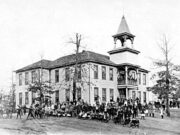Piedmont University, a private liberal arts institution, was founded in 1897 to serve residents of the Appalachian area of northeast Georgia. Today, with campuses located in Demorest and Athens, the college provides undergraduate and graduate degree programs for about 2,800 students from across Georgia and around the world.
History
The story of Piedmont College is tied to the history of Demorest, which was founded in 1889 by the Demorest Home, Mining, and Improvement Company, a group of entrepreneurs. The group built homes, factories, churches, and businesses a few miles from Clarkesville, the seat of Habersham County. Recognizing the need for schools and a college, the company formed the J. S. Green Collegiate Institute, which opened in 1897 with 367 students ranging from first graders to college juniors. The founding president was the Reverend Charles C. Spence, a former Civil War (1861-65) cavalry soldier, Methodist circuit rider, and president of Young Harris College.
The new college ran into early financial trouble and was on the brink of closing its doors when it was adopted by the American Missionary Association (AMA) of the Congregational Church in 1901. The name was changed to Piedmont College to reflect its geographic location. As Georgia public schools improved during the early part of the century, Piedmont discontinued elementary school classes in 1920 at its Piedmont Academy, which had operated as part of the college since 1910, and its high school classes in 1928.
Through the first half of the twentieth century, including World War I (1917-18) and World War II (1941-45), Piedmont continued to fulfill its mission of providing a high-quality college education to Georgia’s mountain youth. During this time, the college was led by presidents noted for their progressive social and academic views: John C. Campbell (1904-7), for whom the Campbell Folk School in Brasstown, North Carolina, is named; Henry Clinton Newell (1907-10 and 1930-36); Frank E. Jenkins (1910-30); George C. Bellingrath (1936-39); Malcolm Boyd Dana (1939-44); and Albert Ray Van Cleave (1944-49).
In 1949, after the college experienced more years of financial difficulties, the AMA ended its affiliation with Piedmont and planned to close it. But the newly elected president, a young Congregational minister named James E. Walter, was determined to save the institution and won support from individual Congregational churches. In 1958 Piedmont affiliated with the newly organized National Association of Congregational Christian Churches, an affiliation that continues. In 2003 Piedmont also affiliated with the United Church of Christ, which includes many of the Congregational churches from which the college had received support. During his thirty-four years as president, Walter rebuilt the campus with nine new buildings, rid the college of debt, established a substantial endowment, and in 1965 secured its first accreditation by the Southern Association of Colleges and Schools (SACS).
Walter retired in 1983, and subsequent presidents continued his efforts to improve the Demorest campus. In 1989 construction of the Arrendale Library began under president D. Garen Simmons (1983-90) and was completed during the term of president John F. Elger (1991-95).
Piedmont Today
The college entered a second period of major campus and academic expansion under president W. Ray Cleere (1995-2011). In a little more than a decade, the college built several academic buildings, residence halls, and athletic facilities at its Demorest campus. In mid-2006 Piedmont began construction of the Center for Performing Arts and Mass Communications in Demorest.
In 1996, the school expanded and opened a second campus in Athens. With the expansion of online degree programs, the Athens campus was then condensed and relocated to a new four-story building along Prince Street in 2021.
In 2011, upon Cleere’s retirement, Danny P. Hollingsworth became president but served only nine months. James Mellichamp was named interim president, then finally became Piedmont’s thirteenth president in 2012.
Enrollment has increased dramatically, from 936 students in 1995 to more than 2,500 in 2021. Piedmont also expanded its academic offerings, opening the R. H. Daniel School of Nursing in Demorest and creating new undergraduate programs in art, education, business, mass communications, environmental science, and physics. Today, the college offers nearly forty undergraduate majors in the arts and sciences and professional disciplines. In 1994 Piedmont began offering graduate degrees and now enrolls about 1,500 students in master’s and specialist’s programs in education, as well as MBA (master of business administration) programs in financial services and managerial leadership.
Sport has always played an important role in the life and health of Piedmont students. The college is a member of the NCAA Division III and competes in a variety of men’s and women’s intercollegiate sports, including baseball, basketball, cross country, golf, soccer, softball, tennis, and volleyball. In recent years, the college has improved all of its athletic facilities and constructed the Walker Athletic Fields, Johnny Mize Athletic Center, and Loudermilk Baseball Complex.
Piedmont College also supports the Lillian E. Smith Center in Clayton. The center, named for the writer and activist Lilliam Smith, who attended Piedmont, provides a quiet mountain retreat for artists and scholars.
In April 2021 the Board of Trustees renamed the school Piedmont University in recognition of the “dramatic growth and transformation” that had occurred over the previous two decades.




